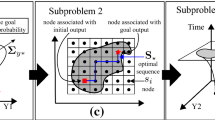Abstract
Few sophisticated problems in the optimal control of a dynamical system can be solved analytically. There are many numerical solution methods, but most, especially those with the most potential accuracy, work iteratively and must be initialized with a guess of the solution. Satisfactory guesses may be very difficult to generate. In this work, a “Reachable Set Analysis” (RSA) method is developed to find near-optimal trajectories for multiphase systems with no a priori knowledge. A multiphase system is a generalization of a dynamical system that includes possible changes on the governing equations throughout the trajectory; the traditional dynamical system where the governing equations do not change is included in the formulation as a special case. The RSA method is based on a combination of metaheuristic algorithms and nonlinear programming. A particularly beneficial aspect of the solution found using RSA is that it satisfies the system governing equations and comes arbitrarily close (to a degree chosen by the planner) to satisfying given terminal conditions. Three qualitatively different multiphase problems, such as a low-thrust transfer from Earth to Mars, a system with chattering arcs in the optimal control, and a motion planning problem with obstacles, are solved using the near-optimal trajectories found by RSA as initial guesses to show the effectiveness of the new method.




























Similar content being viewed by others
References
Bryson, A.E., Ho, Y.C.: Applied Optimal Control, pp. 47–89. Hemisphere, New York (1975)
Hargraves, C.R., Paris, S.W.: Direct trajectory optimization using nonlinear programming and collocation. J. Guid. Control Dyn. 10, 338–342 (1987)
Herman, A.L., Conway, B.A.: Direct optimization using collocation based on high-order Gauss-Lobatto quadrature rules. J. Guid. Control Dyn. 19, 592–599 (1996)
Fahroo, F., Ross, I.M.: Direct trajectory optimization by a Chebyshev pseudospectral method. J. Guid. Control Dyn. 25, 160–166 (2002)
Enright, P.J., Conway, B.A.: Discrete approximations to optimal trajectories using direct transcription and nonlinear programming. J. Guid. Control Dyn. 15, 994–1002 (1992)
Gill, P.E., Murray, W., Saunders, M.A.: User’s Guide for SNOPT Version 7: Software for Large-Scale Nonlinear Programming. Stanford Business Software, Inc. (2007).
Goldberg, D.E.: Genetic Algorithms in Search, Optimization and Machine Learning, pp. 6–14. Addison-Wesley, Reading, MA (1989).
Chilan, C.M., Conway, B.A.: Automated design of multiphase space missions using hybrid optimal control. J. Guid. Control Dyn. 36, 1410–1424 (2013)
Horie, K., Conway, B.A.: Genetic algorithm pre-processing for numerical solution of differential games problems. J. Guid. Control Dyn. 27, 1075–1078 (2004)
Clerc, M., Kennedy, J.: The particle swarm -explosion, stability, and convergence in a multidimensional complex space. IEEE Trans. Evol. Comput. 6, 58–73 (2002)
Ghosh, P., Conway, B.A.: Numerical trajectory optimization with swarm intelligence and dynamic assignment of solution structure. J. Guid. Control Dyn. 35, 1178–1191 (2012)
Englander, J., Conway, B.A., Williams, T.: Automated mission planning via evolutionary algorithms. J. Guid. Control Dyn. 35, 1878–1887 (2012)
Ross, I.M., D’Souza, C.N.: Hybrid optimal control framework for mission planning. J. Guid. Control Dyn. 28, 686–697 (2005)
Chilan, C.M., Conway, B.A.: Using genetic algorithms for the construction of a space mission automaton. In: Proceedings of the IEEE Congress on Evolutionary Computation, pp. 2316–2323. Trondheim, Norway (2009).
Scheel, W.A., Conway, B.A.: Optimization of very-low-thrust, many-revolution spacecraft trajectories. J. Guid. Control Dyn. 17, 1185–1192 (1994)
Cantu-Paz, E., Goldberg, D.E.: On the scalability of parallel genetic algorithms. Evol. Comput. 7, 429–449 (1999)
Schutte, J.F., Reinbolt, J.A., Fregly, B.J., Haftka, R.T., George, A.D.: Parallel global optimization with the particle swarm algorithm. Int. J. Numer. Meth. Eng. 61, 2296–2315 (2004)
Koh, B.-I., George, A.D., Haftka, R.T., Fregly, B.J.: Parallel asynchronous particle swarm optimization. Int. J. Numer. Meth. Eng. 67, 578–595 (2006)
Prussing, J.E.: Primer vector theory and applications. In: Conway, B.A. (ed.): Spacecraft Trajectory Optimization, pp. 16–36. Cambridge University Press, New York (2010).
Schoenauer, M., Michalewics, Z.: Evolutionary computation at the edge of feasibility. Lecture Notes in Computer Science vol. 1141, pp. 245–254 (1996)
Chilan, C.M.: Automated Design of Multiphase Space Missions Using Hybrid Optimal Control. Ph.D. Dissertation, University of Illinois at Urbana-Champaign (2009).
Danby, J.M.A: Fundamentals of Celestial Mechanics, pp. 427–429. Willmann-Bell, Richmond, Virginia (1988).
Robinson, J., Rahmat-Samii, Y.: Particle swarm optimization in electromagnetics. IEEE Trans. Antennas Propag. 52, 397–407 (2004)
Marchal, C.: Chattering arcs and chattering controls. J. Optim. Theory Appl. 11, 441–468 (1973)
Fuller, A.T.: Study of an optimum non-linear control system. J. Electron. Control 15, 63–71 (1963)
Author information
Authors and Affiliations
Corresponding author
Additional information
Communicated by Kenneth D. Mease.
Rights and permissions
About this article
Cite this article
Chilan, C.M., Conway, B.A. A Reachable Set Analysis Method for Generating Near-Optimal Trajectories of Constrained Multiphase Systems. J Optim Theory Appl 167, 161–194 (2015). https://doi.org/10.1007/s10957-014-0651-2
Received:
Accepted:
Published:
Issue Date:
DOI: https://doi.org/10.1007/s10957-014-0651-2




